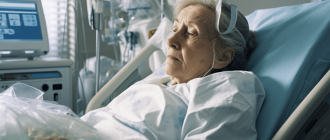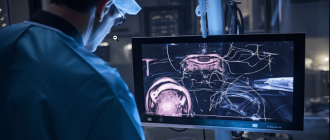Recovery and Rehabilitation After MALS Surgery: What to Expect and How to Support Healing

Dealing with any surgery can be stressful and it is important to have a support system in place to guide you through the recovery process. This is especially true for those who have undergone Median Arcuate Ligament Syndrome (MALS) surgery. MALS is a condition where the median arcuate ligament in the abdomen presses on the celiac artery, causing chronic pain and digestive issues. Surgery to relieve the compression can provide much-needed relief, but the recovery period is crucial for complete healing.
During the initial stages of recovery, it is common to experience some discomfort and pain at the surgical site. Your healthcare team will provide pain management strategies that may include medication or other modalities to help manage the pain. It is important to follow your healthcare professional’s instructions carefully and not hesitate to reach out to them with any concerns or questions.
Rehabilitation plays a vital role in the recovery process after MALS surgery. This may involve physical therapy, exercise, and other interventions to help restore strength and functionality. Your healthcare team will create a personalized rehabilitation plan based on your specific needs and abilities. It is important to adhere to this plan and actively participate in your rehabilitation to optimize your healing and recovery.
Support from loved ones and peers can greatly contribute to your overall healing and well-being. Having someone to talk to and share your experiences with can help alleviate any emotional or psychological stress that may arise during the recovery period. Additionally, having someone assist you with daily activities and provide encouragement can make the recovery process more manageable.
Initial Postoperative Period
After MALS surgery, it is important to understand what to expect in the initial postoperative period in terms of healing, recovery, rehabilitation, and support.
Healing: Following surgery, the body will begin the healing process. The incision site will gradually heal, and any discomfort or pain should decrease over time. It is important to keep the incision clean and follow any wound care instructions provided by the surgeon.
Recovery: The initial recovery period can vary from person to person, but typically patients should expect to stay in the hospital for a few days after the surgery. During this time, the medical team will monitor your condition and provide necessary medications and care. It is normal to feel tired and experience some pain or discomfort during the recovery period.
Rehabilitation: After being discharged from the hospital, rehabilitation may be recommended to help restore strength and functionality. This may include physical therapy exercises and activities tailored to your specific needs. It is important to follow the rehabilitation plan provided by your healthcare team to aid in the recovery process.
Support: The support of loved ones can play a crucial role in the recovery process after MALS surgery. Having a supportive network of family and friends can provide emotional support, help with daily tasks, and assist in following any postoperative instructions. Additionally, joining a support group for individuals who have undergone MALS surgery may be beneficial for sharing experiences and finding encouragement.
In summary, the initial postoperative period after MALS surgery entails healing, recovery, rehabilitation, and support. It is essential to have realistic expectations, follow the recommended care instructions, and seek necessary support to aid in the overall healing and recovery process.
Pain Management Techniques
During the recovery and rehabilitation period after MALS surgery, it is common to experience some pain and discomfort. However, there are various pain management techniques that can help support healing and alleviate discomfort. It is important to follow the guidance of your healthcare team and inform them about any pain you are experiencing, as they can provide personalized recommendations and possibly prescribe pain medication if needed.
Here are some pain management techniques that may be helpful:
- Medication: Your healthcare team may prescribe pain medication to manage post-surgery pain. It is important to take the medication as directed and inform your healthcare team if the prescribed medication does not sufficiently relieve your pain.
- Ice and heat therapy: Applying ice packs or using heating pads can help reduce swelling and alleviate pain. It is important to follow the recommended time limits for each therapy and avoid applying heat to areas with decreased sensation.
- Deep breathing and relaxation techniques: Deep breathing exercises and relaxation techniques, such as meditation or yoga, can help calm your mind and reduce stress levels, which in turn may help manage pain.
- Physical therapy: A physical therapist can guide you through exercises and stretches that promote healing and reduce pain. They may also use techniques such as massage or ultrasound therapy to alleviate muscle tension and discomfort.
- Transcutaneous electrical nerve stimulation (TENS): TENS is a non-invasive technique that uses low-voltage electrical currents to relieve pain. It works by stimulating the nerves and blocking pain signals from reaching the brain.
- Supportive devices: Depending on your specific case, your healthcare team may recommend the use of supportive devices such as abdominal binders or braces to help reduce pain and promote healing.
- Healthy lifestyle habits: Following a healthy lifestyle, including regular exercise, a balanced diet, and sufficient sleep, can contribute to your overall well-being and may help manage pain.
Remember, every individual’s recovery process is unique, and the pain management techniques that work for one person may not work for another. It is important to stay in communication with your healthcare team and inform them about your pain levels and any changes you experience. They can provide guidance and adjust your pain management plan accordingly.
Dietary Adjustments for Better Recovery
After undergoing MALS surgery, it is important to make certain dietary adjustments to support healing and ensure a successful recovery. The right nutrition can help reduce complications, promote tissue repair, and enhance overall well-being. Here are some dietary tips to consider:
- Hydration: Staying hydrated is essential for recovery. Drink plenty of water throughout the day to help flush out toxins and support the healing process.
- Protein: Protein is crucial for healing and tissue repair. Include lean sources of protein such as poultry, fish, beans, and tofu in your meals.
- Fiber: Eating foods high in fiber can help prevent constipation, which is a common side effect of surgery and pain medication. Opt for whole grains, fruits, vegetables, and legumes.
- Vitamins and minerals: A balanced diet rich in vitamins and minerals is important for overall health. Include a variety of fruits and vegetables in your meals to ensure you are getting a wide range of nutrients.
- Avoid processed foods: Processed foods can be high in sodium, unhealthy fats, and artificial additives, which can hinder the healing process. Opt for whole, unprocessed foods whenever possible.
- Small, frequent meals: Instead of large meals, try eating smaller, more frequent meals throughout the day. This can help prevent bloating and promote better digestion.
It is important to remember that everyone’s dietary needs and tolerances are different. Consult with your healthcare provider or a registered dietitian to develop a personalized dietary plan that best supports your recovery after MALS surgery.
Physical Activity Recommendations
After undergoing MALS surgery, it is important to engage in rehabilitation and gradually increase physical activity to support the recovery process. The following are some recommendations to consider:
- Start with gentle activities: In the initial stages of recovery, it is important to gradually introduce physical activity. Begin with simple exercises such as walking or light stretching to improve blood circulation and prevent muscle stiffness.
- Follow a structured rehabilitation program: Consult with your healthcare provider or physical therapist to create a personalized rehabilitation plan. This plan may include exercises to strengthen the core muscles, improve flexibility, and enhance overall mobility.
- Listen to your body: Pay attention to how your body responds to physical activity. If you experience pain or discomfort, modify or reduce the intensity of the exercise. It is important to avoid overexertion and allow your body time to heal.
- Gradually increase activity levels: As your strength and endurance improve, gradually increase the duration and intensity of your physical activity. This could include increasing the distance and pace of your walks, adding resistance to strength training exercises, or progressing to more challenging yoga or pilates sessions.
- Include a variety of exercises: Incorporate a mix of cardiovascular exercises, strength training, and flexibility exercises into your routine. This will help improve overall fitness, maintain a healthy weight, and prevent muscle imbalances.
- Stay hydrated: Drink plenty of water before, during, and after exercise to stay hydrated and support proper bodily function.
- Take rest days: Allow your body time to rest and recover. Schedule regular rest days to prevent overtraining and optimize the healing process.
Remember, every individual’s recovery process is unique, and it is essential to follow the guidance of your healthcare provider or physical therapist. They can provide personalized recommendations based on your specific needs and surgical outcomes. By gradually increasing physical activity and listening to your body, you can support your rehabilitation and promote a successful recovery after MALS surgery.
Wound Care and Surgical Incision Healing
Proper wound care is crucial for the healing process and recovery after MALS surgery. Following your surgery, you can expect to have a surgical incision that will need to be cared for and monitored for signs of infection and proper healing. Here are some guidelines to support the healing of your surgical incision:
- Keep the incision clean: Gently clean the incision with mild soap and water daily. Be sure to pat the area dry with a clean towel.
- Protect the incision: Cover the incision with a sterile dressing or bandage to protect it from dirt and bacteria. Change the dressing as directed by your healthcare provider.
- Avoid strenuous activities: During the initial recovery period, it is essential to avoid any activity that might put stress on the incision, such as heavy lifting or intense physical exercise.
- Monitor for signs of infection: Watch for signs of infection, such as increased redness, swelling, warmth, or fluid leakage from the incision. Contact your healthcare provider if you notice any of these symptoms.
- Follow your surgeon’s instructions: Your surgeon will provide you with specific instructions for wound care and incision healing. It is important to follow these instructions carefully to optimize your recovery and minimize the risk of complications.
It is crucial to remember that everyone’s healing process may vary, and there might be some discomfort and swelling in the area around the incision. However, if you have any concerns or experience severe pain, bleeding, or other worrisome symptoms, it is important to contact your healthcare provider promptly.
In addition to wound care, it is essential to focus on overall rehabilitation, physical therapy, and a healthy lifestyle to support your healing after MALS surgery. Your healthcare provider will guide you through the recovery process and provide you with personalized recommendations based on your specific needs and condition.
Potential Complications and Warning Signs
While recovery and healing are common after MALS surgery, it is important to be aware of potential complications that may arise. Knowing what to expect and the warning signs to look out for can help you in supporting your rehabilitation process and seeking medical attention when needed.
Infection: In some cases, infection may occur at the incision site or within the abdomen. Signs of infection may include increased pain, redness, swelling, discharge, or fever. It is important to keep your incision clean and dry, and to seek medical attention if you suspect an infection.
Bleeding: While some bleeding is normal after surgery, excessive bleeding may be a sign of a complication. If you notice increased bleeding, or if bleeding does not decrease over time, contact your doctor immediately.
Wound dehiscence: Wound dehiscence refers to the separation of the surgical incision. This can occur due to excessive strain or infection. It may be characterized by a visible gap in the incision, increased pain, or discharge. If you suspect wound dehiscence, contact your doctor immediately.
Adverse reactions to anesthesia: Some individuals may have adverse reactions to anesthesia, such as allergic reactions or complications related to underlying health conditions. If you experience difficulty breathing, chest pain, or other unusual symptoms after surgery, seek medical attention immediately.
Dysphagia: Dysphagia, or difficulty swallowing, may occur after MALS surgery. This can be a temporary side effect due to muscle manipulation during the procedure. However, if dysphagia persists or worsens over time, it may require further evaluation and treatment.
Delayed healing: While healing is expected after surgery, sometimes the healing process may be delayed. Factors such as underlying health conditions, poor nutrition, or infection can contribute to delayed healing. If you notice that your incision is not healing as expected, or if you experience prolonged pain or other unusual symptoms, contact your doctor.
Nerve damage: In some cases, MALS surgery can damage nearby nerves. This may lead to symptoms such as numbness, tingling, or weakness in the affected area. If you experience any unusual neurological symptoms after surgery, inform your doctor immediately.
Recurrence of symptoms: Although MALS surgery aims to relieve symptoms, there is a possibility of symptom recurrence. If you notice that your symptoms return or worsen after a period of improvement, it is important to consult your doctor for further evaluation and potential treatment options.
Remember to closely follow your doctor’s post-operative instructions and attend all scheduled follow-up appointments. If you experience any concerning symptoms or have questions about your recovery and rehabilitation process, do not hesitate to reach out to your medical team for support and guidance.
Medication Management and Follow-Up Appointments
After MALS surgery, medication management and follow-up appointments play a crucial role in supporting the recovery process and promoting healing. It is important to understand what to expect in terms of medication and the frequency of follow-up appointments.
Medication Management:
- Pain Medication: Pain medication will likely be prescribed to manage any post-surgical discomfort. Your healthcare provider will discuss the type of pain medication, dosage, and frequency with you. It is essential to follow the prescribed guidelines and communicate any concerns or side effects to your healthcare provider.
- Antibiotics: Antibiotics may be prescribed to prevent infection after surgery. It is important to take the prescribed antibiotics as directed and complete the full course of treatment.
- Other Medications: Depending on your specific needs, your healthcare provider may prescribe additional medications to manage symptoms or support your recovery. Follow the instructions for these medications carefully.
Follow-Up Appointments:
Follow-up appointments allow your healthcare provider to monitor your progress, address any concerns, and make adjustments to your treatment plan as needed. The frequency of follow-up appointments may vary depending on individual circumstances, but they are typically scheduled within the first few weeks after surgery.
- The first follow-up appointment usually occurs within 1-2 weeks after surgery.
- Subsequent follow-up appointments may be scheduled every few weeks or months, depending on your progress.
- During these appointments, your healthcare provider will assess your healing, review any necessary tests or imaging, and discuss any symptoms or concerns you may have.
It is important to attend all scheduled follow-up appointments and communicate openly with your healthcare provider about your recovery and any challenges you may be experiencing.
Conclusion:
Medication management and follow-up appointments are integral components of the recovery and rehabilitation process after MALS surgery. Consistently following the prescribed medication plan and attending all scheduled appointments will support healing, monitor progress, and ensure personalized care throughout the recovery journey.
Emotional Support and Coping Strategies
Recovery from MALS surgery can be a challenging and overwhelming experience. It is important to have a strong support system in place to help you cope with the emotional and physical challenges that arise during the healing process.
Here are some strategies to help you navigate your recovery and find emotional support:
- Reach out to loved ones: Inform your family and friends about your surgery and recovery process. They can offer emotional support and help with daily activities, such as meal preparation or household chores.
- Join support groups: Consider joining online or in-person support groups for individuals who have undergone MALS surgery or other similar procedures. These groups provide a safe space to share experiences, ask questions, and find support from others who have gone through similar situations.
- Seek professional help: If you find yourself struggling with anxiety, depression, or other mental health issues during your recovery, do not hesitate to reach out to a mental health professional. They can provide guidance and support tailored to your specific needs.
- Practice self-care: Take time for yourself and engage in activities that bring you joy and relaxation. This can include hobbies, reading, taking walks, or practicing mindfulness and meditation.
- Set realistic expectations: Understand that recovery from MALS surgery takes time and patience. Be gentle with yourself and try not to compare your progress to others. Celebrate small victories along the way.
- Communicate with your healthcare team: Stay in touch with your healthcare providers and share any concerns or questions you may have. They can provide valuable information and reassurance during your recovery journey.
Remember, healing from MALS surgery is a process that involves both physical and emotional aspects. By seeking support, practicing self-care, and communicating with your healthcare team, you can better navigate the challenges and find the strength to heal.
Rest and Sleep for Optimal Healing
When recovering from MALS surgery, rest and sleep are crucial for supporting your body’s healing process. Proper rest allows your body to focus its energy on repairing tissues, reducing inflammation, and regaining strength. It is important to prioritize rest and quality sleep throughout your rehabilitation journey.
Here are a few key points to keep in mind regarding rest and sleep during your recovery:
- Make sleep a priority: Getting enough quality sleep is essential for your body’s healing and overall well-being. Aim for at least 7-9 hours of uninterrupted sleep each night. Establishing a regular sleep schedule can help support your body’s natural sleep-wake cycle.
- Create a comfortable sleep environment: Ensure that your bedroom is a relaxing and peaceful space. Use blackout curtains or an eye mask to block out light, invest in a supportive mattress and pillows, and maintain a comfortable room temperature. These factors can contribute to a more restful sleep.
- Practice relaxation techniques: Engage in relaxation techniques such as deep breathing exercises, meditation, or gentle stretching before bedtime. These activities can help calm your mind and prepare your body for sleep.
- Avoid stimulating substances: Limit your intake of caffeine and avoid nicotine and alcohol, especially in the evening. These substances can interfere with your sleep quality and disrupt your ability to fall asleep or stay asleep.
- Listen to your body: Pay attention to your body’s cues and rest when you feel fatigued or low on energy. Pushing yourself too hard can impede the healing process and prolong your recovery time.
- Engage in light activity: While rest is important, it is also beneficial to engage in light activity during the day. Take short walks or perform gentle stretching exercises to promote blood circulation and prevent muscle stiffness.
- Seek support: Reach out to your healthcare team if you are having difficulty sleeping or if you experience prolonged feelings of fatigue. They can provide guidance and support to help improve your sleep quality and overall well-being.
Remember, recovery after MALS surgery is a gradual process, and rest and sleep play a significant role in supporting your healing journey. Listen to your body, practice good sleep hygiene, and prioritize self-care to optimize your recovery.
Gradual Return to Daily Activities
After MALS surgery, it is important to support the rehabilitation process and allow for proper healing. Although the exact recovery timeline can vary for each individual, there are general expectations for a gradual return to daily activities.
1. Walking: Walking is usually encouraged as soon as possible after surgery. It helps improve blood flow and aids in the healing process. Initially, short walks may be recommended, gradually increasing in duration and intensity over time.
2. Light Exercises: As the body heals, light exercises that focus on mobility and flexibility can be introduced. This can include gentle stretching exercises, yoga, or swimming. It is important to consult with your healthcare provider before starting any new exercise routine.
3. Dietary Considerations: Following MALS surgery, your healthcare provider may provide guidance on dietary considerations. This may include a gradual transition to solid foods and an emphasis on a balanced diet rich in fruits, vegetables, and lean proteins.
4. Gradual Increase in Work Activities: Returning to work activities will vary depending on the nature of the job and the individual’s recovery progress. It is important to communicate with your healthcare provider and discuss any modifications or accommodations that may be needed during the transition back to work.
5. Social and Recreational Activities: Engaging in social and recreational activities is an important aspect of recovery and overall well-being. As healing progresses, individuals can gradually reintroduce social gatherings, hobbies, and recreational activities into their routine. It is crucial to listen to your body and avoid overexertion.
6. Emotional Support: Recovery and healing after MALS surgery can be a challenging and emotional time. It is important to seek emotional support from loved ones, support groups, or mental health professionals, if needed. This support can help navigate the recovery process and promote overall well-being.
Always consult with your healthcare provider for personalized guidance and support throughout the recovery process. Each individual’s recovery experience may vary, and it is important to listen to your own body and prioritize your well-being during this time.
Rehabilitation Exercises for a Stronger Body
After undergoing surgery for Median Arcuate Ligament Syndrome (MALS), a proper rehabilitation program is crucial for a full recovery. This includes a combination of exercises that focus on regaining strength, flexibility, and overall physical well-being.
1. Deep Breathing Exercises: Deep breathing exercises are an important part of the recovery process. They help improve lung function and prevent post-surgical complications such as pneumonia. Take slow, deep breaths and try to expand your lungs as much as possible.
2. Core Strengthening: Strengthening the core muscles is essential for building a stronger body. Perform exercises like planks, bird dogs, and abdominal crunches to target these muscles. Start with gentle exercises and gradually increase the intensity as you progress.
3. Cardiovascular Exercises: Engaging in cardiovascular exercises helps improve overall cardiovascular health and endurance. Choose low-impact exercises like walking, swimming, or cycling to reduce the strain on the body. Aim for at least 30 minutes of cardiovascular activity each day.
4. Flexibility and Stretching: Stretching exercises are important for improving flexibility and range of motion. Incorporate exercises like yoga or Pilates into your routine to help increase flexibility. Make sure to stretch all major muscle groups to prevent muscle imbalances and promote better posture.
5. Resistance Training: Resistance training helps build muscle strength and improve overall body composition. Use resistance bands or dumbbells to perform exercises like bicep curls, shoulder presses, and squats. Start with light weights and gradually increase the resistance as your strength improves.
6. Balance and Coordination Exercises: After surgery, it’s common to experience a loss of balance and coordination. Perform exercises that challenge your balance, such as standing on one leg or using a balance board. These exercises will help improve stability and prevent falls.
7. Postural Exercises: MALS surgery can have an impact on your postural alignment. Incorporate exercises that focus on improving your posture, such as shoulder retractions and chin tucks. These exercises will help correct any imbalances and promote better posture.
8. Rest and Recovery: Along with exercise, it’s important to prioritize rest and recovery. Allow your body enough time to heal and listen to any signals of fatigue or pain. Make sure to get an adequate amount of sleep each night and take rest days when needed.
Remember, each person’s recovery journey is unique, and it’s important to work with your healthcare team to create a personalized rehabilitation plan. They will guide you through each step of the process and provide support along the way.
Resuming Work and Social Life
After undergoing MALS surgery, it is important to have realistic expectations about the recovery and healing process. Returning to work and social activities may take some time, depending on the individual’s condition and the extent of the surgery. Here are some things to expect and ways to support the healing during this phase:
- Gradual Return: It is crucial to allow the body enough time to recover before resuming work and social life. Your doctor will provide specific guidelines based on your condition. It is common to start with reduced working hours or modified duties initially and gradually increase your workload over time.
- Physical Restrictions: You may experience some physical limitations during the early stages of recovery. Avoid lifting heavy objects or participating in strenuous activities until you receive clearance from your doctor. Follow post-operative instructions and listen to your body’s signals to avoid any setbacks.
- Support System: Surround yourself with a strong support system during this recovery phase. Friends, family, and colleagues can provide emotional support, assist with daily tasks, or help with work-related responsibilities if needed.
- Communication: Openly communicate with your employer and colleagues about your recovery process. Inform them about any necessary schedule modifications or workplace accommodations that you may require temporarily. Maintaining open lines of communication can help reduce stress and ensure a smooth transition back to work.
- Self-Care: Focus on self-care and prioritize your well-being during this phase. Engage in activities that promote relaxation, such as meditation, gentle exercises, or hobbies that bring you joy. It is essential to listen to your body’s needs and give yourself enough time to heal fully.
- Gradual Socializing: Social activities may also need to be eased back into slowly. Attending events or gatherings may be tiring initially, so it is important to pace yourself and not overexert. Choose social engagements that provide a supportive and low-stress environment.
Remember that everyone’s recovery process is unique, and it is crucial to follow the guidance of your healthcare team. Be patient with yourself, and do not hesitate to ask for help or support when needed. With time and proper care, you will gradually be able to resume your work and social activities.
Monitoring for Long-Term Results and Prevention
After MALS surgery, it is important to monitor the long-term results and take preventive measures to support recovery and healing. This involves regular follow-up appointments with your healthcare provider and making lifestyle changes to minimize the risk of complications.
During your follow-up appointments, your healthcare provider will assess your progress and monitor the effectiveness of the surgery. They may perform diagnostic tests such as imaging scans or blood tests to evaluate your blood flow and identify any potential issues. These tests can help detect any recurring symptoms or complications.
It is crucial to communicate any persistent or new symptoms to your healthcare provider during these follow-up visits. This can include symptoms such as abdominal pain, digestive problems, or weight loss. By sharing this information, your healthcare provider can address any concerns and adjust your treatment plan if needed.
In addition to regular check-ups, lifestyle modifications can support long-term recovery and prevent future complications. These may include:
- Dietary changes: Follow a balanced and nutritious diet that includes plenty of fruits, vegetables, lean proteins, and whole grains. Avoid foods that may trigger symptoms or put additional strain on your digestive system.
- Exercise: Engage in regular physical activity to maintain a healthy weight and promote blood flow. Consult with your healthcare provider to develop an exercise plan that suits your specific needs and limitations.
- Stress management: Practice stress-reducing techniques such as meditation, deep breathing exercises, or engaging in hobbies that you enjoy. Chronic stress can exacerbate symptoms and hinder recovery.
- Medication management: Take any prescribed medications as directed by your healthcare provider. These may include pain medications, digestive aids, or medications to manage any underlying conditions such as hypertension or diabetes.
- Supportive therapy: Consider joining a support group or seeking counseling to address any emotional or psychological challenges associated with the recovery process. Sharing experiences and coping strategies with others who have undergone similar surgeries can provide valuable support.
By actively participating in monitoring your long-term results and implementing preventive measures, you can support your recovery and reduce the risk of complications. Remember to communicate openly with your healthcare provider and seek their guidance whenever necessary.
Support Groups and Online Communities
Support groups and online communities can play a crucial role in the recovery and rehabilitation process after MALS surgery. These groups provide individuals with a space to connect with others who are going through a similar experience, share their stories, and offer each other support.
Joining a support group or online community can be beneficial in many ways. First and foremost, it allows individuals to feel less alone in their journey. MALS surgery can be a challenging and isolating experience, but connecting with others who have had similar surgeries can provide a sense of comfort and reassurance.
Support groups also serve as a valuable source of information and advice. Members can share their own experiences and offer tips on managing pain, coping with post-surgery symptoms, and navigating the recovery process. They can also provide recommendations for healthcare providers, physical therapists, and other specialists who are familiar with MALS and can provide the necessary support.
When considering joining a support group or online community, it is important to find one that aligns with individual needs and preferences. Some groups may focus more on emotional support, while others may prioritize sharing practical advice and resources.
Here are a few options to consider:
- MALS Support Group: This dedicated support group brings together individuals who have undergone MALS surgery. Members can share their experiences, offer support, and ask questions in a safe and understanding environment.
- Chronic Illness Communities: Online communities focused on chronic illnesses can also be a valuable resource for MALS patients. These groups provide a platform for individuals to connect with others who are managing similar health challenges.
- Recovery and Rehabilitation Forums: Forums and discussion boards focused on recovery and rehabilitation can be a great way to connect with individuals who are going through the same journey. These platforms often have sections dedicated to specific surgeries, including MALS.
Overall, the support gained from these groups can be invaluable during the recovery and rehabilitation process after MALS surgery. Whether seeking emotional support or practical advice, connecting with others who understand the unique challenges of MALS can make a significant difference in the healing process.
Follow-Up Testing and Imaging
After undergoing MALS surgery, regular follow-up testing and imaging are crucial to monitor the healing process and ensure the success of the procedure. These tests and imaging studies help provide important information about the status of the surgical site and the patient’s overall recovery.
The type and frequency of follow-up testing and imaging will vary depending on the individual patient and the specific details of their surgery. However, here are some common tests and imaging studies that a patient can expect:
- Physical Examination: A physical examination by the surgeon or healthcare provider is often one of the first steps in follow-up care. The surgeon will check for any signs of complications or issues with healing.
- Blood Tests: Blood tests may be performed to assess various factors such as liver and kidney function, as well as to monitor for any signs of infection or inflammation.
- Imaging Studies: Imaging studies such as ultrasound, CT scans, or magnetic resonance angiography (MRA) may be ordered to evaluate the blood flow in the abdominal region and to check for any residual compression or obstruction in the celiac artery.
- Barium Swallow Test: In some cases, a barium swallow test may be recommended to assess the functioning and movement of the esophagus and stomach.
- Follow-Up Consultations: Regular follow-up consultations with the surgeon or healthcare provider will allow them to evaluate the patient’s overall progress and address any concerns or questions they may have.
It is important for patients to follow all recommended follow-up testing and imaging appointments to ensure that any potential issues or complications can be identified and addressed promptly. Compliance with the follow-up care plan is crucial for a successful recovery and rehabilitation after MALS surgery.
Managing Expectations and Patience
Supporting recovery and healing after MALS surgery requires a realistic understanding of what to expect during the rehabilitation process. It is important to remember that every individual’s journey to recovery is unique, and there may be variations in the time it takes for full healing.
It is normal to want to see immediate results after surgery, but it is essential to be patient and allow the body enough time to heal fully. Some individuals may experience a gradual improvement in symptoms, while others may have a more rapid recovery. It is crucial not to compare one’s progress to others and focus on personal healing.
Recovery from MALS surgery involves both physical and emotional healing. Some of the common physical challenges after surgery may include fatigue, pain at the incision site, difficulty with eating and digestion, and a gradual return to normal activities. It is essential to follow the healthcare provider’s instructions and guidelines for post-operative care.
Emotional and psychological healing is equally important during the recovery process. It is not uncommon for individuals to experience anxiety or frustration due to the disruption caused by the surgery. It is important to share these feelings with loved ones and seek support from healthcare professionals, if needed.
During the recovery period, there may be ups and downs, and it is important to be prepared for setbacks. It is normal to experience occasional setbacks in the healing process, but with time and patience, gradual progress can be made.
Here are a few tips to manage expectations and cultivate patience during the recovery and rehabilitation phase after MALS surgery:
- Stay positive: Maintain a positive mindset and stay optimistic about the healing process.
- Follow post-operative instructions: Adhere to the healthcare provider’s guidelines for wound care, physical activity, and dietary restrictions.
- Seek support: Reach out to loved ones, friends, or support groups who can provide emotional support during the recovery journey.
- Be patient with yourself: Recognize that healing takes time, and it is normal to have ups and downs.
- Celebrate small victories: Acknowledge and appreciate the progress made each day, no matter how small.
- Practice self-care: Engage in activities that promote relaxation and well-being, such as gentle exercise, meditation, or hobbies.
- Communicate with healthcare providers: If there are any concerns or questions during the recovery process, do not hesitate to reach out to the healthcare team for guidance and reassurance.
By managing expectations and practicing patience, individuals can support their recovery and healing process effectively after MALS surgery. Remember that each person’s healing journey is unique, and it is important to focus on personal progress rather than comparing oneself to others.
Q&A:
What is MALS surgery?
MALS surgery stands for Median Arcuate Ligament Syndrome surgery. It is a surgical procedure performed to address the compression of the celiac artery by the median arcuate ligament, which can cause abdominal pain and digestive symptoms.
How long does recovery after MALS surgery take?
The recovery time after MALS surgery varies from person to person, but it generally takes several weeks to a few months. It depends on factors such as the individual’s overall health, the extent of the surgery, and how well they follow their doctor’s post-operative instructions.
What can I expect during the recovery period?
During the recovery period, you can expect to experience some pain and discomfort at the incision site, as well as fatigue and limited mobility. Your doctor may prescribe pain medication to manage the discomfort, and it is important to rest, eat a healthy diet, and gradually increase your activity level as advised by your healthcare team.
How can I support my healing after MALS surgery?
To support healing after MALS surgery, it is important to follow your doctor’s instructions carefully. This may include taking prescribed medications, attending follow-up appointments, practicing good nutrition, getting enough rest, and slowly increasing your physical activity as directed. It is also important to reach out to your healthcare team if you have any concerns or questions during your recovery.
Are there any potential complications or risks during the recovery period?
While complications are rare, they can occur during the recovery period after MALS surgery. Some potential risks include infection, bleeding, blood clots, or complications related to general anesthesia. It is important to closely follow your doctor’s instructions and notify them if you experience any unusual symptoms or complications.
What is MALS surgery?
MALS surgery, also known as median arcuate ligament syndrome surgery, is a procedure performed to treat a condition called median arcuate ligament syndrome. This condition occurs when the median arcuate ligament, which is a ligament in the abdomen, compresses the celiac artery, causing pain and other symptoms. MALS surgery involves releasing the ligament to relieve the compression and improve blood flow.
What are the common symptoms of median arcuate ligament syndrome?
Common symptoms of median arcuate ligament syndrome include abdominal pain, especially after eating, weight loss, nausea, vomiting, and diarrhea. These symptoms may be chronic and may significantly impact a person’s quality of life.






